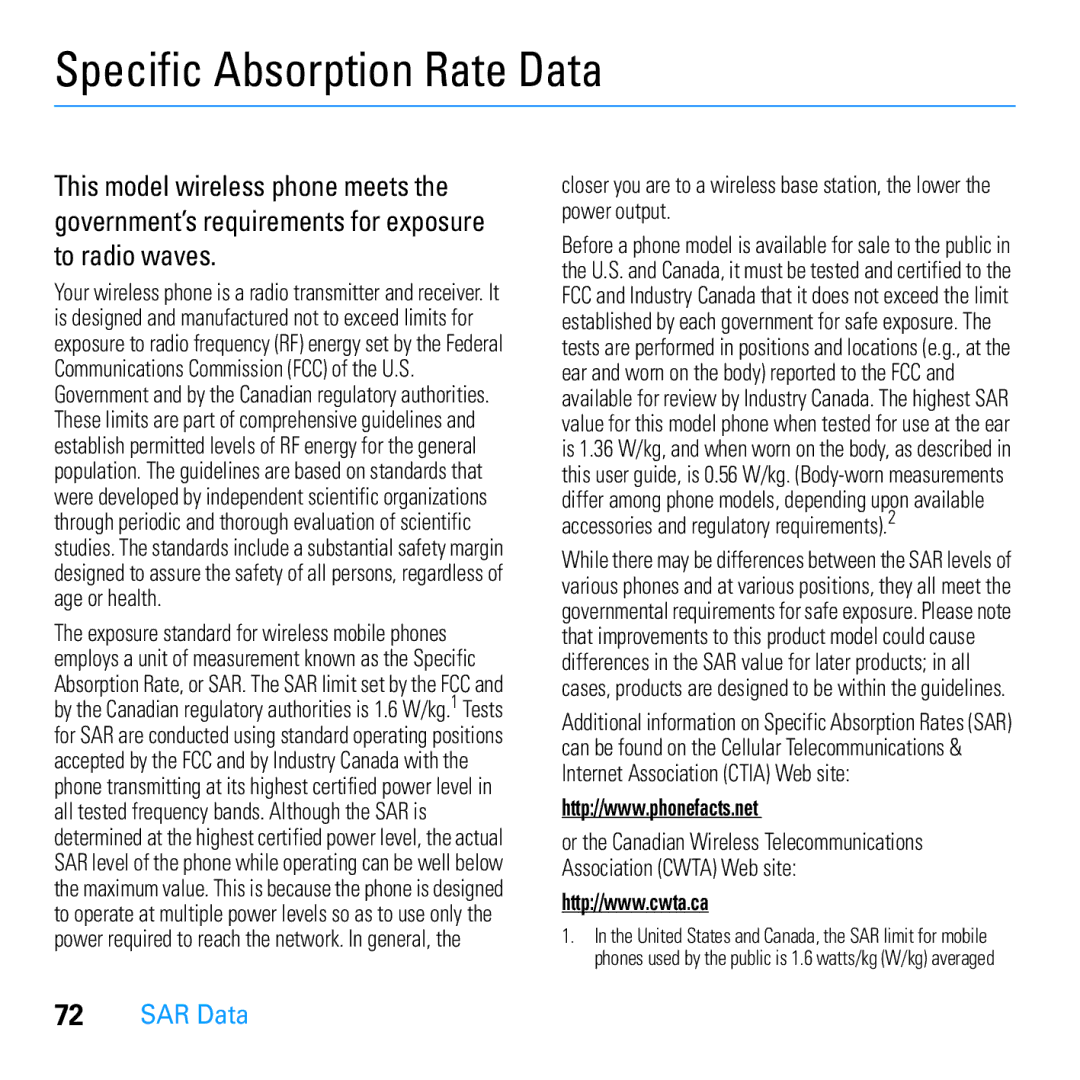Moto U9
Page
Hellomoto
Camera Lens
Home Screen
Software Copyright Notice
Motorola, Inc United States Canada
Motorola, Inc., 2008. All rights reserved
Manual Number 68000201412-A
Contents
Other features
Main menu
Optional features
Menu map
Settings menu
Home Screen
Use and Care
Above gives an example of a typical Product Approval Number
EU Conformance
All other relevant EU Directives
Essentials
This guide uses the following symbols
Symbols
About this guide
Battery charging
Battery
Battery use & safety
DON’Ts
DOs
Proper and Safe Battery Disposal Recycling
Display
Home screen appears when you turn on Phone
Basics
Basics
Location Indicator Shows P
Bluetooth Indicator Shows Bluetooth status
Message Indicator Shows when
Profile Indicator Shows the alert profile setting
Text entry
Some features let you enter text
Word mode see Abc mode see Numeric mode see Symbol mode see
= line Call forward on
Punctuation or other characters
Word mode
Enter punctuation Press 1to enter
Display
Abc mode
For example, if you press Your display might show
Symbol mode
Volume
Numeric mode
Side select key
Set phone ring style in the external display
Voice commands
External display
Use touch keys in the external display
Voice activate phone functions
Wait for the beep, then say a command from the list
Voice commands
Tips
Handsfree speaker
Codes & passwords
Talking phone
If you forget your unlock code At
Lock & unlock external keys
Find it s u Settings Security External Key Lock Timer
Lock at Power On On
Lock & unlock phone
Profiles
Change alert style settings
Customize
Customize
Edit or delete profiles
Alert style, press Options Reset
Create a new profile
Create Profile
Time & date
Restore alert style settings
Restore Sound Settings
Time and Date
Apply a photo as wallpaper
Themes
Preview ringtones
Edit
Press S right to select the images tab $
Modify a theme
Create a new theme
Press S left/right to select the sounds tab or images tab $
To turn the internal display screensaver on or off
Display appearance
Answer options
Options
Recent calls
Calls
Turn off a call alert
Calls
Caller ID
Redial
Return a call
To show or hide your phone number for all calls
Emergency calls
Voicemail
Music player
Set the default song format and bit rate on your computer
Entertainment
Entertainment
Supported audio formats
Convert iTunes AAC files to MP3 files on your computer
Manually transfer music to your phone or memory card
On your phone
On your computer
When you finish, remove the phone safely from your computer
Play music
On your computer. a
Hide Hide the music player while
Device over a Bluetooth
Music player options
Screen, then press Sup
Customize the music player
My Bookmarks bookmark
Browser settings
Browser
Following Web site
Camera
Take a photo
Find it s j Multimedia Camera
Auto-send
Camera settings
View a photo
Settings
Videos
Record a video
Upload video to a blog
Play a video
Supported video formats
Send a message
Messages
Text messaging
Messages
Receive a message
More message & email features
Features Confirm a message was sent
Send a prewritten quick note
Send email
Features Set up email accounts
Features Read old messages
Use a multimedia template
Features Browser messages
Info services
File manager
Connections
Sync with SyncML
Connections
Move or copy files between the phone and memory card
Cable connections
Format memory card
On a PC running Windows XP or later
End a USB connection
To manually transfer music, pictures,
On a PC running an earlier version
Use a Bluetooth headset or handsfree car kit
Bluetooth wireless
Turn Bluetooth power on or off
To turn Bluetooth power on or off at any time
Before you try to copy a file to another
Copy files to another device
Receive files from another device
Before you try to receive a file from another
Settings Connections Bluetooth, press S left to select
More Bluetooth features
Features Pair with recognized device
Send a photo to a printer
Set Bluetooth options
Phone updates
Features Drop connection with device
Remove device from device list
Advanced calling
Other features
Other features-advanced calling
Make another call during a call
Features Call waiting
Features Transfer a call
Conference call
Fixed dial
Features Change phone line
Features Service dial
Dtmf tones
Other features-contacts
Contacts
Assign contact to category
Features Set ring ID for contact
Features Create group mailing list
Set category view
Manage SIM card contacts
Features Import contacts to phone memory
Features Send contacts to another device
Delete contacts
Other features-personalize
Personalize
Other features-call times & costs
Call times & costs
Other features-handsfree
Handsfree
Personal organizer
Other features-network
Network
Other features-personal organizer
Record voice note
Features
Features Calculator
Play voice note
Fun & games
Other features-security
Security
If you have questions or need assistance, were here to help
Service & repairs
Service & repairs
Specific Absorption Rate Data
SAR Data
OSS Information
OSS Management North US Hwy Libertyville, IL
Index
Index
Handsfree speaker 2, 23 headset
Message read 48, 49 send
Voicemail message indicator
Word text entry mode World clock Patent Re ,976
